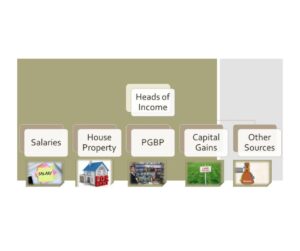![]()

Heads of income
Under the concept of total income, there are various heads or categories of income that are considered for the purpose of computing an individual’s or a business’s overall income. The specific heads of income may vary depending on the tax laws and regulations of a particular country.
However, the common heads of incomes include the following:
1.Salary and wages:
This head includes income earned through employment, including regular salary, bonuses, allowances, and perquisites.
2.Income from house property:
This head encompasses rental income derived from owning a property, such as a house or a commercial building.
3.Profits and gains from business or profession:
Income generated from carrying out a trade, business, or profession falls under this head. It includes income earned by self-employed individuals, entrepreneurs, and professionals.
4.Capital gains:
Any income arising from the sale or transfer of capital assets, such as stocks, real estate, or investments, is categorized as capital gains.
5.Income from other sources:
This head covers income that does not fall under the other specific heads mentioned above. It includes income from interest, dividends, royalties, lottery winnings, and other miscellaneous sources.
For more information to visit: https://www.incometax.gov.in
The total income is calculated by aggregating the income from each of these heads after considering applicable deductions, exemptions, and allowances as per the tax laws of the respective jurisdiction. The tax liability is then determined based on the total income and the tax rates applicable to each income bracket.
Therefore, It is essential to consult with a tax advisor or refer to the tax regulations in your country to understand the specific heads of income and their treatment for computing total income.
For further details access our website https://vibrantfinserv.com